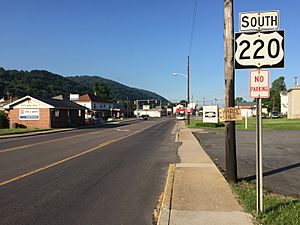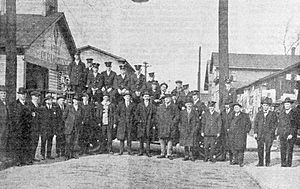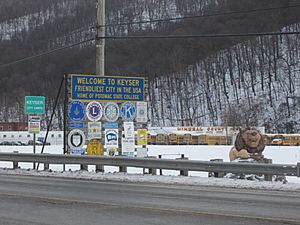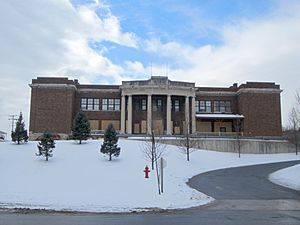Keyser, West Virginia facts for kids
Quick facts for kids
Keyser, West Virginia
The Irish Settlement (c.1752)
Paddy Town (c.1752-1855) Wind Lea (1855-c.1860) New Creek (c.1860-1874) |
|
|---|---|
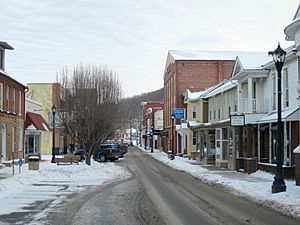
Downtown Keyser in January 2014
|
|
| Nickname(s):
Friendliest City in the USA
|
|
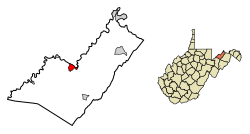
Location of Keyser in Mineral County, West Virginia.
|
|
| Country | United States |
| State | West Virginia |
| County | Mineral |
| Incorporated/Chartered | 1874/1913 |
| Government | |
| • Type | Mayor-council government |
| Area | |
| • Total | 1.98 sq mi (5.12 km2) |
| • Land | 1.98 sq mi (5.12 km2) |
| • Water | 0.00 sq mi (0.00 km2) |
| Elevation | 968 ft (295 m) |
| Population
(2020)
|
|
| • Total | 4,853 |
| • Estimate
(2021)
|
4,860 |
| • Density | 2,488.61/sq mi (960.77/km2) |
| Time zone | UTC-5 (Eastern (EST)) |
| • Summer (DST) | UTC-4 (EDT) |
| ZIP Code |
26726
|
| Area code(s) | 304 |
| FIPS code | 54-43492 |
| GNIS feature ID | 2390605 |
Keyser (pronounced KY-zer) is a city in West Virginia, USA. It is the main town, or county seat, of Mineral County. Keyser is located near the Potomac River. In 2020, about 4,853 people lived there.
Contents
History
Keyser is in the eastern part of West Virginia. It sits where the North Branch of the Potomac River meets New Creek. The city is named after William Keyser, who worked for the Baltimore and Ohio Railroad.
The first land in this area was given to Christopher Beelor in 1752. The place was first called Paddy Town, named after Patrick McCarty, an Irish immigrant. It was also known as "the Irish Settlement." After 1755, during the French and Indian War, Native American forces attacked Paddy Town many times.
In the early 1800s, the Chesapeake and Ohio Canal (C&O Canal) was built. It went along the Potomac River from Washington, DC, to Cumberland, Maryland. The canal never reached Paddy Town. By 1844, Paddy Town was struggling. But things got better in 1852 when the Baltimore & Ohio Railroad arrived. The railroad helped the town's economy grow. Sometime around 1855, the town changed its name to New Creek Station.
The American Civil War reached New Creek Station in 1861. The Union army built Fort Fuller there. The railroad, which had helped the town, now made it a target. Confederate forces attacked New Creek many times because of its important location. The area changed hands 14 times during the war. On November 28, 1864, Confederate soldiers took over Fort Fuller. They destroyed most of the buildings in the town.
After the war, in 1866, Mineral County was formed. New Creek became the county seat, and a courthouse was finished in 1868. In 1874, the Baltimore & Ohio Railroad decided to put its main offices in the town. So, on November 16, 1874, the town was officially named Keyser. It was named after William Keyser, a vice president of the railroad. Keyser also got railroad repair shops and a roundhouse, which created many jobs. Keyser was also important in the Great Railroad Strike of 1877.
Keyser grew a lot in the 1880s. More businesses came to the city. Besides the B&O, the Western Maryland Railroad and the West Virginia Central Railroad also hired workers. In 1913, Keyser officially became the "City of Keyser." In 1924, a big flood from the Potomac River caused a lot of damage to homes and businesses.
In the 1900s, Keyser's economy depended a lot on factories and the railroad. After World War II, the town had another growth period. However, in the 1970s and early 1980s, many factories closed. Today, Keyser's jobs are mostly in health care, education, and service industries. Potomac State College is a big part of the community.
The Thomas R. Carskadon House and Mineral County Courthouse are important historic buildings. They are listed on the National Register of Historic Places.
Geography
Keyser covers about 1.92 square miles (5.12 square kilometers) of land. It is in a valley next to the North Branch of the Potomac River. New Creek forms most of the town's eastern border. On the east side of New Creek is New Creek Mountain. To the west is the Allegheny Front, a high ridge. The Potomac River is to the north. Across the river in McCoole, Maryland, there is a large rock cliff called Queens Point. It offers great views of Keyser.
Today, you can see many wind turbines on Keyser's western horizon. The NedPower Mount Storm Wind Farm started building in 2006. It has 162 wind turbines, making it the largest east of the Mississippi River.
Keyser's oldest part is downtown, with the 1868 courthouse. The main streets are Main and Armstrong. Armstrong Street runs next to the CSX railroad tracks. Across the tracks is a neighborhood called the North End. Potomac State College is on Fort Hill, a small hill in the center of the city. The south end of Keyser has newer homes built in the 1960s and 1970s. This area is called Airport Addition because it used to be a small airport.
The main roads in Keyser are U.S. Route 220 and West Virginia Route 46. U.S. Route 220 goes north to Cumberland and south into Virginia. West Virginia Route 46 goes west to Piedmont and east to Fort Ashby.
Climate
| Climate data for Keyser, West Virginia (1991–2020 normals, extremes 1996–present) | |||||||||||||
|---|---|---|---|---|---|---|---|---|---|---|---|---|---|
| Month | Jan | Feb | Mar | Apr | May | Jun | Jul | Aug | Sep | Oct | Nov | Dec | Year |
| Record high °F (°C) | 72 (22) |
82 (28) |
90 (32) |
96 (36) |
99 (37) |
103 (39) |
104 (40) |
103 (39) |
102 (39) |
96 (36) |
84 (29) |
80 (27) |
104 (40) |
| Mean daily maximum °F (°C) | 39.5 (4.2) |
43.8 (6.6) |
53.0 (11.7) |
66.5 (19.2) |
75.5 (24.2) |
83.9 (28.8) |
88.6 (31.4) |
86.5 (30.3) |
79.7 (26.5) |
67.4 (19.7) |
54.3 (12.4) |
43.3 (6.3) |
65.2 (18.4) |
| Daily mean °F (°C) | 30.1 (−1.1) |
32.8 (0.4) |
40.6 (4.8) |
51.8 (11.0) |
61.3 (16.3) |
69.9 (21.1) |
74.7 (23.7) |
72.8 (22.7) |
65.7 (18.7) |
53.8 (12.1) |
42.5 (5.8) |
34.1 (1.2) |
52.5 (11.4) |
| Mean daily minimum °F (°C) | 20.7 (−6.3) |
21.9 (−5.6) |
28.2 (−2.1) |
37.2 (2.9) |
47.1 (8.4) |
56.0 (13.3) |
60.9 (16.1) |
59.1 (15.1) |
51.7 (10.9) |
40.3 (4.6) |
30.6 (−0.8) |
24.9 (−3.9) |
39.9 (4.4) |
| Record low °F (°C) | −11 (−24) |
−7 (−22) |
−2 (−19) |
18 (−8) |
28 (−2) |
38 (3) |
45 (7) |
43 (6) |
31 (−1) |
20 (−7) |
11 (−12) |
−3 (−19) |
−11 (−24) |
| Average precipitation inches (mm) | 2.77 (70) |
2.57 (65) |
3.79 (96) |
3.85 (98) |
4.54 (115) |
4.34 (110) |
3.83 (97) |
3.25 (83) |
3.57 (91) |
3.11 (79) |
2.74 (70) |
3.04 (77) |
41.40 (1,052) |
| Average snowfall inches (cm) | 9.6 (24) |
10.3 (26) |
5.5 (14) |
0.2 (0.51) |
0.0 (0.0) |
0.0 (0.0) |
0.0 (0.0) |
0.0 (0.0) |
0.0 (0.0) |
0.2 (0.51) |
1.1 (2.8) |
6.6 (17) |
33.5 (85) |
| Average precipitation days (≥ 0.01 in) | 13.6 | 12.6 | 13.6 | 14.7 | 15.7 | 13.5 | 11.3 | 12.3 | 10.3 | 11.0 | 10.2 | 12.5 | 151.3 |
| Average snowy days (≥ 0.1 in) | 6.5 | 6.2 | 4.4 | 0.5 | 0.0 | 0.0 | 0.0 | 0.0 | 0.0 | 0.1 | 1.0 | 4.1 | 22.8 |
| Source: NOAA | |||||||||||||
Transportation
Keyser has two main highways. U.S. Route 220 goes north from Keyser into Maryland and south into Virginia. West Virginia Route 46 goes west to Piedmont and east to Fort Ashby.
Economy and Jobs
In 2016, many people in Keyser worked in factories, health care, or service jobs. Others worked in sales, food service, education, or administration.
Some of the biggest employers in Keyser are:
- Northrop Grumman: This company makes parts for the military in nearby Rocket Center.
- WVU Medicine Potomac Valley Hospital: A local hospital.
- Wal-Mart Stores: A large retail store.
- Potomac State College of West Virginia University: A college that is part of West Virginia University.
- Mineral County Board of Education: The local school system.
- Keyser Healthcare Center by CommuniCare: A nursing home.
- Automated Packaging Systems: A company that makes packaging machines.
- West Virginia Department of Highways: Works on roads and transportation.
- Information Manufacturing Inc.
- Lumber and Things: Makes wooden pallets.
People and Population
| Historical population | |||
|---|---|---|---|
| Census | Pop. | %± | |
| 1880 | 1,693 | — | |
| 1890 | 2,165 | 27.9% | |
| 1900 | 2,563 | 18.4% | |
| 1910 | 3,705 | 44.6% | |
| 1920 | 6,003 | 62.0% | |
| 1930 | 6,248 | 4.1% | |
| 1940 | 6,177 | −1.1% | |
| 1950 | 6,347 | 2.8% | |
| 1960 | 6,192 | −2.4% | |
| 1970 | 6,586 | 6.4% | |
| 1980 | 6,569 | −0.3% | |
| 1990 | 5,870 | −10.6% | |
| 2000 | 5,303 | −9.7% | |
| 2010 | 5,439 | 2.6% | |
| 2020 | 4,853 | −10.8% | |
| 2021 (est.) | 4,860 | −10.6% | |
| U.S. Decennial Census | |||
In 2010, there were 5,439 people living in Keyser. Most residents were White (88.4%), and 8.6% were African American. About 1.4% of the population was Hispanic or Latino.
The average age in Keyser was about 36 years old. About 19.4% of the people were under 18.
Education
Keyser is home to Potomac State College of West Virginia University. This college helps students prepare for a four-year university degree.
The schools in Keyser are part of the Mineral County Schools district. They include:
- Keyser Primary School (Pre-K to 4th grade)
- Fountain Primary School (Pre-K to 4th grade)
- Keyser Middle School (5th to 8th grade)
- Keyser High School (9th to 12th grade)
- Mineral County Alternative School
- Mineral County Technical Center (a school for learning job skills)
The mascot for Keyser High School is the "Golden Tornado."
Media
Keyser has a local newspaper called the Mineral News and Tribune.
There are also three radio stations in Keyser:
- WQZK 94.1 FM (plays popular music)
- WKYW 102.9 FM (plays folk music)
- WKLP 1390 AM (plays sports)
Notable people
Many interesting people have connections to Keyser:
- William Armstrong (1782–1865) – A U.S. representative from Virginia.
- Woodrow Wilson Barr (1918–1942) – A soldier in World War II who received the Silver Star. He was born in Keyser.
- Henry Louis Gates Jr. (born 1950) – A famous historian, author, and professor. He was born in Keyser.
- Jonah Edward Kelley (1923–1945) – A World War II soldier who received the Medal of Honor. He grew up in Keyser.
- John Kruk (born 1961) – A former Major League Baseball player and now an ESPN analyst. He grew up in Keyser.
- Catherine Marshall (1914–1983) – An American author known for her inspiring books, like Christy. She grew up in Keyser.
- Leo Mazzone (born 1948) – A Major League Baseball pitching coach. He was born in Keyser.
- Walter E. Rollins (1906–1973) – A songwriter who wrote "Frosty the Snowman" and "Smokey Bear".
- Harley Orrin Staggers (1907–1991) – A U.S. Congressman. He was born in Keyser.
See also
 In Spanish: Keyser (Virginia Occidental) para niños
In Spanish: Keyser (Virginia Occidental) para niños


